Art & Exhibitions
New York Gallery Beat: Offbeat Summer Group Shows
Our critics on Carrie Mae Weems, Nick Cave, Martin McCormack, and others.

Photo: Courtesy Taymour Grahne Gallery.
Our critics on Carrie Mae Weems, Nick Cave, Martin McCormack, and others.

Artnet News

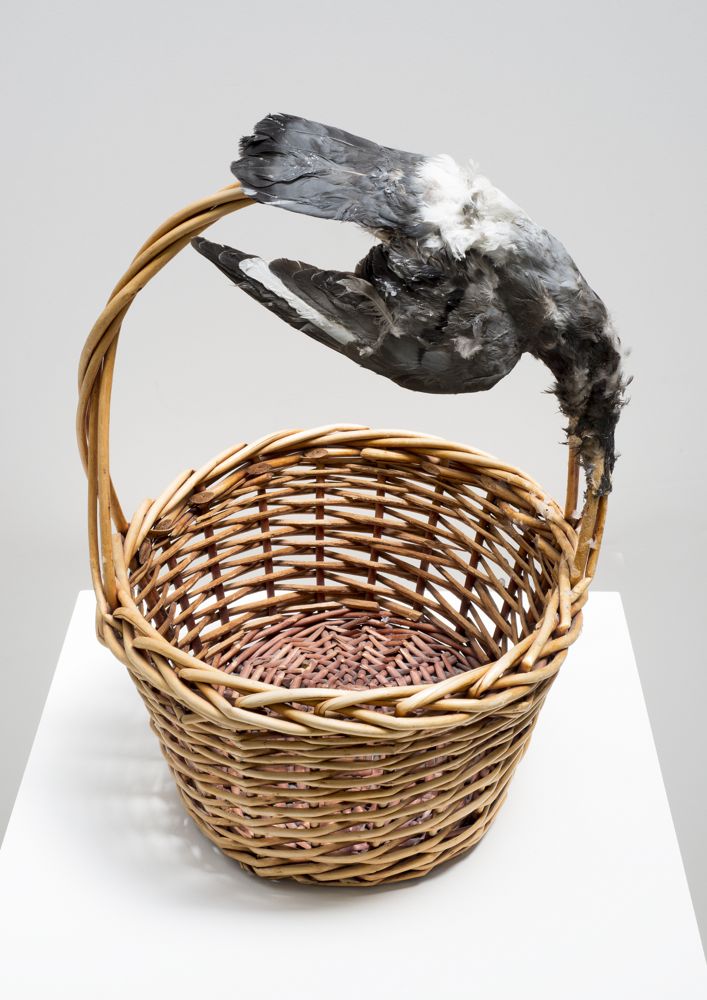
Smith, Michael E., Untitled, 2014, pigeon, basket, plastic. Photo: Courtesy Bill Orcutt.
“Another Look at Detroit” at Marianne Boesky and Marlborough Chelsea, through August 8
This joint exhibition about Detroit’s creative riches has a kind of Alice-in-Wonderland-interrupted feel to it. Entering Boesky, at the end of a large, nearly empty room, dimly lit by a couple of dangling Edison bulbs, we discovered a book enclosed in a vitrine and opened it to a page with a sentence written on it in such tiny writing that it’s impossible to read it with bare eyes. Picking up the provided magnifying glass, we looked closely—but squinting and squinting as hard as we could, we could not make out the sentence. Though we walked away puzzled from that work, The One Page Book (1972) by James Lee Byars, what stayed with us throughout the show was the feeling that we were getting acquainted with a curious culture. You can’t help but consider Detroit’s declaration of bankruptcy, a year ago this month, while perusing the show, which has a kind of gritty stoicism to it. From a chaotic canvas by Julie Mehretu to a noble but lugubrious oil portrait of Edsel B. Ford by Diego Rivera, Metroplex record albums laid out on a rough-hewn wood bench, or a red punk jacket by Anna Sui hanging defiantly from a hanger in mid-air, these works, whether of visual art, design, fashion, or music, feel all of a piece, like artifacts of a civilization both full of poetry and accustomed to pulling itself up by its bootstraps. —Rozalia Jovanovic

Ridykeulous, The Advantages of Being a Lesbian Woman Artist (2007) at Klaus von Nichtssagend Gallery.
Photo: Benjamin Sutton.
“Daughter of Bad Girls” at Klaus von Nichtssagend Gallery, through July 27.
Twenty years after concurrent feminist art exhibitions—“Bad Girls” at the New Museum, curated by Marcia Tucker, and “Bad Girls West” at what would become the Hammer Museum, curated by Marcia Tanner—this small show sets out to check in on the place of feminism in contemporary art but comes off feeling startlingly apolitical. A few outspoken pieces redeem the concept, like Ridykeulous’s hilarious lesbian-themed update of the Guerrilla Girls’s The Advantages of Being a Woman Artist, and Xaviera Simmons’s orgasmic take on Manet’s Olympia. Otherwise, these daughters of “Bad Girls” are far less badass than their predecessors. —Benjamin Sutton
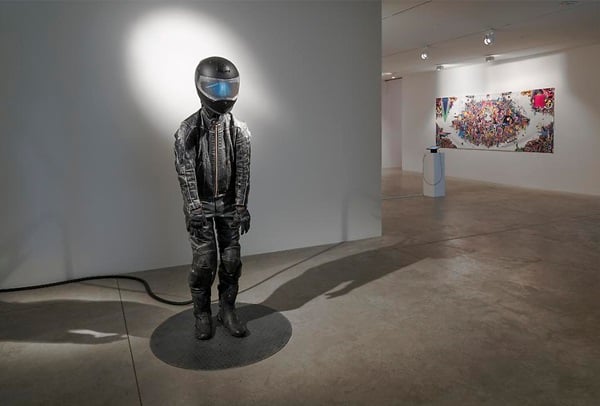
Installation view of “Duality of Existence—Post Fukushima” at Friedman Benda, with Yusuke Suga’s Mediator [foreground]
“Duality of Existence—Post Fukushima” at Friedman Benda, through August 9.
Three years after the Tōhoku earthquake tsunami and the Fukushima Dai-ichi nuclear disaster, curators Reiko Tsubaki and Thorsten Albertz bring together a group of Japanese artists, established and emerging, for an appraisal of the realities of Japanese identity and experience surrounding these tragic events. Offering a pluralistic picture of the Japanese present, the pieces fluctuate between two central themes: the fragility of life and the impact of technology. A work like Motohiko Odani‘s slow-motion images of searing hot metal plunging into water, Dead Man Sleeping, contrasts to eerie images speed and technology elsewhere in the show, for instance in Yusuke Suga’s Mediator, a life-size sculpture of a black-clad spaceman, with images of a flickering highway projected into his visor. —Lorraine Rubio
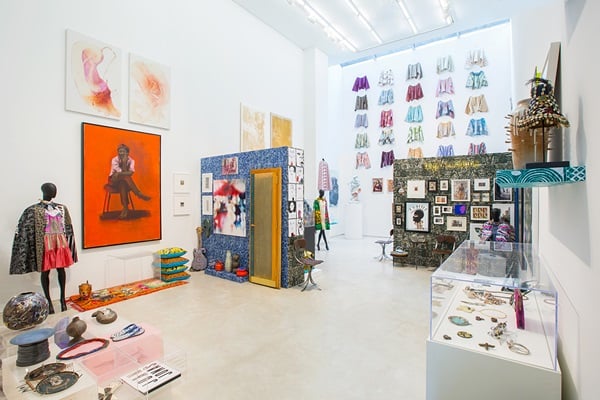
London-based fashion designer Duro Olowu curated “More Material” at Salon 94 Bowery. Photo: Courtesy Jeff Elstone/Salon 94.
“Duro Olowu: More Material” at Salon 94 Bowery, through August 1
Prodigious doesn’t even begin to cover the amount and scope of material that London fashion designer Duro Olowu has managed to fit in Salon 94’s downstairs gallery space (the upper level has a pop-up boutique featuring Olowu’s fashion). The show is focused on how women and the female form have inspired artists and designers. Says Olowu, who curated a previous show in 2012 at Salon 94 Freemans: “My ongoing discovery of both the new and the old is key to my personal joie de vivre.” Indeed. The fact that the dazzling array of objects—encompassing contemporary and vintage art and photography, textiles, furniture, ceramics and found objects—makes it difficult to decide where to rest your eye matters not at all. It’s all the more fun when you spy a Lynette Yiadom-Boakye portrait above a ceramic lion by Paa Joe on an orange rug with a stack of brilliantly patterned pillows, or a giant Nick Cave soundsuit that fits perfectly amid elaborately costumed mannequins and vintage West African photography from Studio Lumiere and Pigeon Voyageur in Porto Novo, Benin. Other notable artists represented here include Cindy Sherman, Carrie Mae Weems, Malick Sidibé, Juergen Teller, former Hole bassist Melissa Auf der Mar, and Claude and Francois Lalanne. —Eileen Kinsella

Shirana Shahbazi [Diver-02-2011] (2011), gelatin silver print on aluminum.
Photo: Courtesy Taymour Grahne Gallery.
“Fixed Unknowns” and “Didn’t Start the Fire” at Taymour Grahne, through September 6
As part of “Fixed Unknowns,” a group show offering the top gallery of Taymour Grahne, curators Ava Ansari and Molly Kleiman have had the good sense to give Shirana Shahbazi’s gelatin silver print on aluminum [Diver-02-2011] (2011) its own wall. This depiction of a shadowed diver, configured in a shape that recalls oh, so many references, stands out as a beauty in this show. Debatably, however, the arresting work by Shahbazi (one of the featured photographers in MoMA’s 2012 new photography show) is eclipsed by the evidence of process-based work in other corners of the gallery. Hannah Whitaker’s Ship of Theseus (2014) is one example. A gridded formation of 16 archival pigment prints marked by squares, it contains images of . . . paper towels. Yes: paper towels, dark and light. According to curator Kleiman, the artist actually placed a paper towel within her camera and shot “with” it. I had no chance to ask the artist herself about this method, but did catch a few moments with another artist, Yui Kugimiya, whose work appears in Taymour Grahne’s downstairs exhibition “Didn’t Start The Fire” (after the Billy Joel song). Kugimiya’s diminutive oil-on-canvas Ripping Afternoon (2013) had me back for a second look and then a third. This painting features a turquoise patch (not unlike the shape of the state of Illinois) set within a yellow color field that bleeds other colors at the edges. “Oh,” curator Nadia Ayari mentioned: “She makes her own paint” (and MoMA’s permanent collection contains five of her very short videos). Kugimiya told me: “The making of the paint is to give a starting point to the narrative of making a painting.” She uses only Kremer pigments. “When materials are handcrafted, they are inconsistent. The uniqueness of the materials brings a unique outcome. I like incorporating accidental qualities in my work, something that is not machine-made.” So: Kremer Pigments are a Yes, but anything resembling Winsor & Newton is a big No-No. Absolutely ripping. —Elizabeth Manus
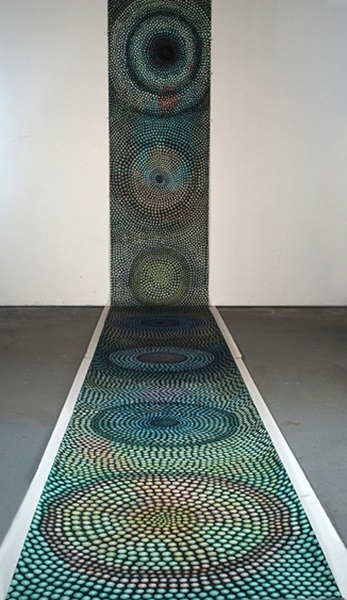
Sky Kim Untitled (2013) watercolor on paper. Photo: Courtesy Garis & Hahn
“Leaps into the Void: Shamanism, Meditation, Transcendence, Oblivion” at Garis & Hahn, through August 16
This group show of mixed-media work by five artists feels like the visual equivalent of a cool breeze on a hot summer day: from Sky Kim’s continuous repetition of patterns, to Phoebe Rathnell’s intricate net-like paintings, Gwyn Joy’s compelling collages referencing shamanistic power, and Michael Maxwell’s work that reflect his exploration into altered states of consciousness. The exhibition, which borrows its title from Yves Klein’s famous photograph of the same name, frames each artist’s works in the context of meditation and altered mental states, transcendence, and belief systems about life and death. The show climaxes on the lower level with Joe Nanashe’s arresting installation Prometheus, which uses sound, structure, and light—or, more specifically, stepladders and spotlights, and four keyboards set in a square formation, leaning atop another, emitting a continuous, soothing drone scored by the artist himself to set the tone for “celestial ascent.” —Eileen Kinsella
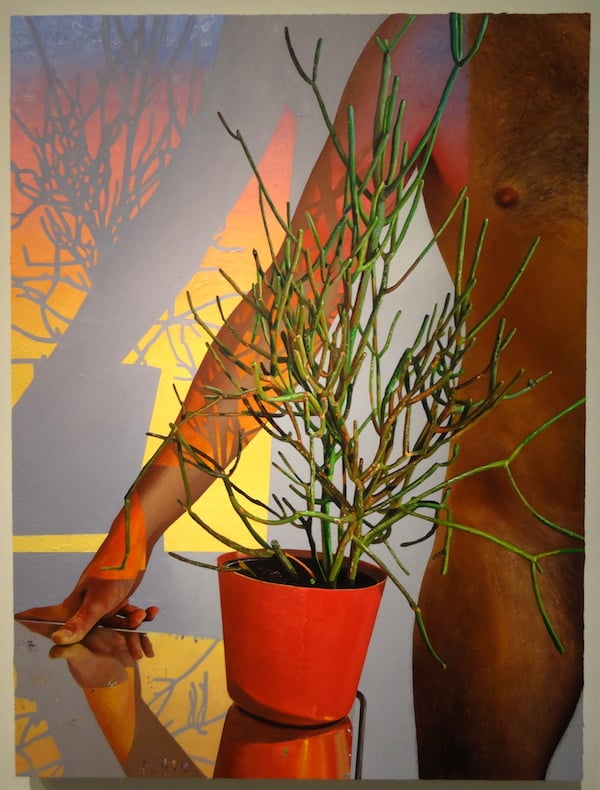
Robin F. Williams, Mr. X (2014) at Sargent’s Daughters.
Photo: Benjamin Sutton.
“Sargent’s Daughters” at Sargent’s Daughters, through July 26.
The nine-month-old gallery’s eponymous exhibition is a belated thesis statement, with works by some 40 artists allegedly illustrating the many ways that John Singer Sargent’s influence endures to this day. It makes for a fun game of “Spot the Sargent Touch” as you wander the gallery, with some connections—like Robin F. Williams’s typically dazzling painting Mr. X (2014), a reversal of the conventional male-female, portraitist-sitter dynamic of old—coming across more successfully than others—like Betty Tompkins’s print depicting a blow-job in extreme closeup. But even where the link is dubious (if there are some Sargent fellatio paintings I don’t know about, dear readers, please let me know), the selection of works is generally very fresh and makes for a satisfying summer sampler. —Benjamin Sutton
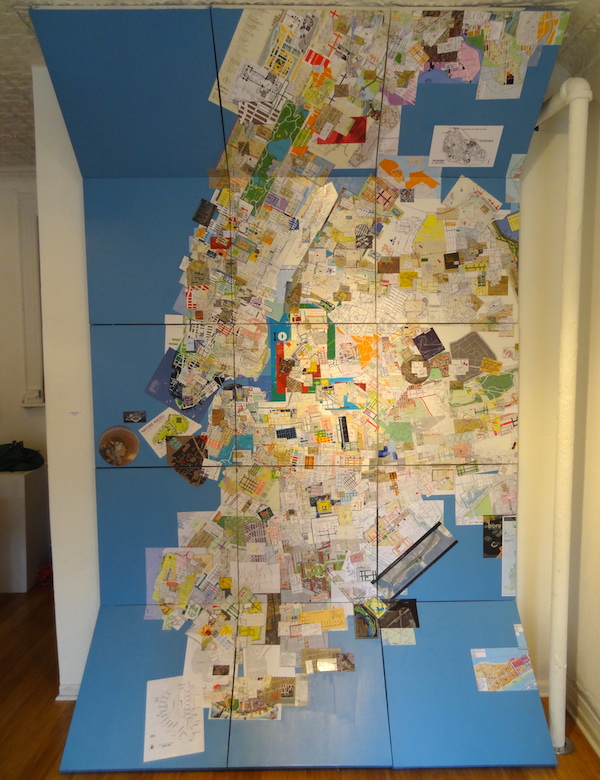
Martin McCormack, The Great New York City Mapping Project (2009) at Ground Floor Gallery.
Photo: Benjamin Sutton.
“Staycation” at Ground Floor Gallery, through August 17.
Works in this cartography-themed summer show fall along the highway between figurative paintings of through-the-windshield road trip landscapes (Lindsey Warren) and geometric abstraction (Greg Slick). The most memorable works take a more psycho-geographic approach to the idea of mapping, particularly the free-associative paintings of Jose Arenas and Martin McCormack’s amazing large-scale collage—a map of New York City cobbled together from various neighborhood maps. All the works are strong, but McCormack’s huge meta-map is what makes this show a must-visit during your New York City summer staycation. —Benjamin Sutton
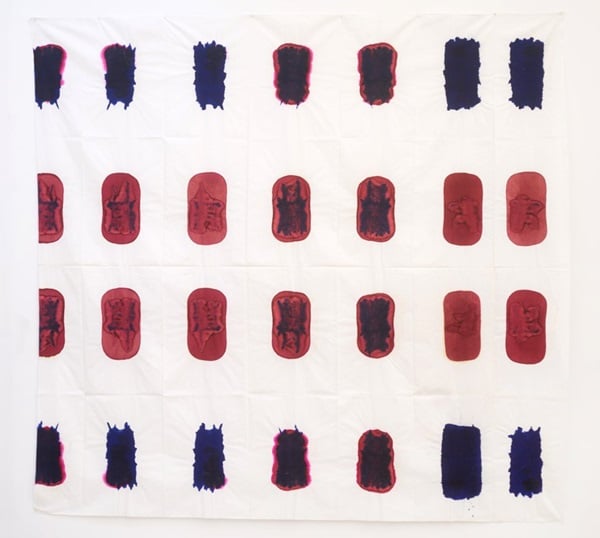
Patrick Saytour, Pliage (1973)
Photo: Courtesy Canada
“Supports/Surfaces” at Canada, through July 20
There’s just a week left to catch the summer’s most intellectually rewarding group show, resurrecting France’s heretofore obscure Supports/Surfaces cell of painters. Amid all the soul-searching of the ‘60s, the artists identified with Supports/Surfaces fed abstract painting through a cheesecloth of radical theory, and came out with something that has the knowingly indistinct feeling of Blinky Palermo or Richard Tuttle but with a jaunty, Mediterranean vibe. They feel like decorations for an experimental-art picnic. These colorful works, which deliberately seek to boil painting down to its most indolent fundamentals—Patrick Saytour’s Pliage (1973), a white sheet studded with a regular pattern of red and blue paint-blobs—reveal a careful sense of artistic composition if you stick around to really think about them. —Ben Davis